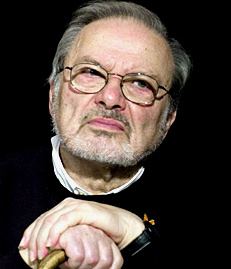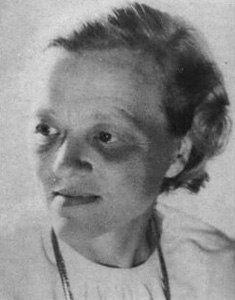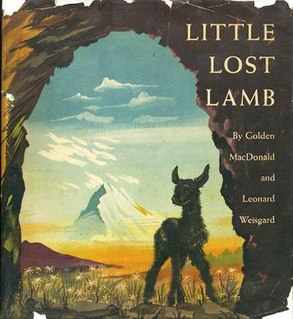Related Research Articles

A picture book combines visual and verbal narratives in a book format, most often aimed at young children. With the narrative told primarily through text, they are distinct from comics, which do so primarily through sequential images. The images in picture books can be produced in a range of media, such as oil paints, acrylics, watercolor, and pencil.

Maurice Bernard Sendak was an American illustrator and writer of children's books. He became widely known for his book Where the Wild Things Are, first published in 1963. Born to Polish-Jewish parents, his childhood was affected by the death of many of his family members during the Holocaust. Sendak also wrote works such as In the Night Kitchen, Outside Over There, and illustrated many works by other authors including the Little Bear books by Else Holmelund Minarik.

Margaret Wise Brown was an American writer of children's books, including Goodnight Moon and The Runaway Bunny, both illustrated by Clement Hurd. She has been called "the laureate of the nursery" for her achievements.
Ruth Ida Krauss was an American writer of children's books, including The Carrot Seed, and of theatrical poems for adult readers. Many of her books are still in print.

Feodor Stepanovich "Rojan" Rojankovsky, also known as Rojan, was a Russian émigré illustrator. He is well known both for children's book illustration and for erotic art. He won the 1956 Caldecott Medal for U.S. picture book illustration from the American Library Association, recognizing Frog Went A-Courtin' by John Langstaff.

Marie Hall Ets was an American writer and illustrator who is best known for children's picture books. She attended Lawrence College, and in 1918, Ets journeyed to Chicago where she became a social worker at the Chicago Commons, a settlement house on the northwest side of the city. There she met Ines Cassettari, an immigrant from Italy who worked at the settlement. Ets transcribed Cassettari's autobiography, and the book was later published as Rosa: The Life of an Italian Immigrant.
Leonard Joseph Weisgard was an American writer and illustrator of more than 200 children's books. He is known best for his collaborations with writer Margaret Wise Brown.
The Lewis Carroll Shelf Award was an American literary award conferred on several books annually by the University of Wisconsin–Madison School of Education annually from 1958 to 1979. Award-winning books were deemed to "belong on the same shelf" as Alice's Adventures in Wonderland and Through the Looking-Glass by Lewis Carroll, having enough of the qualities of his work.
Beatrice Schenk de Regniers was an American writer of children's picture books.
Ursula Nordstrom was publisher and editor-in-chief of juvenile books at Harper & Row from 1940 to 1973. She is credited with presiding over a transformation in children's literature in which morality tales written for adult approval gave way to works that instead appealed to children's imaginations and emotions.
The Northeast Children's Literature Collection (NCLC) is housed at Archives & Special Collections at the University of Connecticut. The purpose of the Northeast Children’s Literature Collection is to preserve the history of the creation of our best literature written for children. Emphasis is given to the perception of children’s literature as a form of art over other educational or social intentions. Archives are collected to document the process of children’s book creation by authors and illustrators in collaboration with agents, editors, designers and publishers.

Outside Over There is a picture book for children written and illustrated by Maurice Sendak. It concerns a young girl named Ida, who must rescue her baby sister after the child has been stolen by goblins. Outside Over There has been described by Sendak as part of a type of trilogy based on psychological development from In the Night Kitchen (toddler) to Where the Wild Things Are (pre-school) to Outside Over There (pre-adolescent).

Marla Frazee is an American author and illustrator of children's literature. She has won two Caldecott Honors for picture book illustration.
I Can Read! is a line of beginning reading books published by HarperCollins. The series is rated by level and is widely used to teach children to read English. The first book in the series was Else Holmelund Minarik's Little Bear, published in 1957, and subsequent notable titles have included Amelia Bedelia and Frog and Toad.

A Very Special House, written by Ruth Krauss and illustrated by Maurice Sendak, is a 1953 picture book published by HarperCollins. A Very Special House was a Caldecott Medal Honor Book for 1954 and was Sendak's first Caldecott Honor Medal of a total of seven during his career. Sendak won the Caldecott Medal in 1964 for Where the Wild Things Are, which he both authored and Illustrated. A Very Special House was re-issued by HarperCollins in 2001 in hardcover format as part of a project to re-issue 22 Sendak works including several authored by Ruth Krauss.

Mr. Rabbit and the Lovely Present, written by Charlotte Zolotow and illustrated by Maurice Sendak, is a 1962 pictures book published by HarperCollins. It was a Caldecott Medal Honor Book for 1963 and was one of Sendak's Caldecott Honor Medal of a total of seven during his career. Sendak won the Caldecott Medal in 1964 for Where the Wild Things Are, which he both authored and illustrated. Mr. Rabbit and the Lovely Present was re-issued by HarperCollins in 1999 in hardcover format as part of a project to re-issue 22 Sendak works, including several authored by Zolotow.
Leonard S. Marcus is an American author and expert on English language children's literature. Marcus has been a critic for several publications including Horn Book and the New York Times Book review. Born and raised in Mount Vernon, New York, he attended Yale University and was editor of the Yale Literary Magazine.
W. R. Scott was a children's literature publisher based in New York City that specialized in visually striking books with a contemporary educational philosophy. W. R. Scott's first editor was Margaret Wise Brown; the company also published a number of her books.

Little Lost Lamb is a 1945 picture book by Margaret Wise Brown writing as Golden MacDonald and illustrated by Leonard Weisgard. The story is about a shepard who goes searching for a missing lamb. The book was a recipient of a 1946 Caldecott Honor for its illustrations.
What Do You Say, Dear? is a 1958 picture book written by Sesyle Joslin and illustrated by Maurice Sendak. The book is a humorous take on a book about manners. The book was a recipient of a 1959 Caldecott Honor for its illustrations.
References
- ↑ "Caldecott Medal & Honor Books, 1938-Present". American Library Association. Retrieved 9 March 2010.
- 1 2 3 Something About the Author, volume 2. (Gale Research, 1971), pages 158-9
- ↑ "Sesyle Joslin".